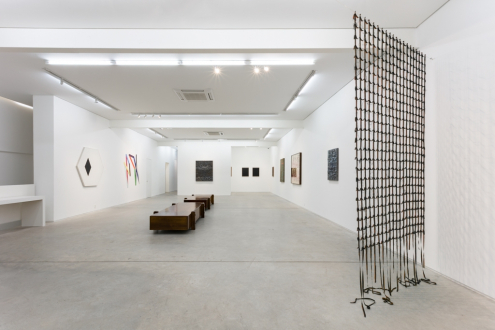Frank Ammerlaan exhibits in group exhibition Simões de Assis Galeria de Arte

Frank Ammerlaan exhibits in group exhibition Simões de Assis Galeria de Arte
Matéria em Desvio | Acervo
28/01/2020 to 07/03/2020
São Paulo - Simões de Assis Galeria de Arte
Artists: André Azevedo , Eliane Prolik , Frank Ammerlaan , Geraldo de Barros , José Bechara , Juan Parada , Julia Kater , Luiz Schwanke , Rodrigo Torres .
MATTER SHIFT
The dialogue suggested between the works of the collections of Simões de Assis Gallery and SIM Gallery is guided by the shift idea. In particular the shift of the use of some classic materials within the field of Art to develop the works here gathered. The present voices subvert the notion of artistic making from the displacement of elements and devices from other domains into their artistic poetics.
When mentioning classic materials of the Art world, the most common techniques are considered within two traditional artistic disciplines: painting (oil, acrylic, watercolor, gouache on paper or canvas) and sculpture from stone, metal, clay or wood. Different among themselves, the artists invest in the pictorial and spatial media, equipped with a vast formal and material repertoire. Taking as a first example the great figure of Geraldo de Barros (Chavantes, SP, 1923-1988) who, at a late stage of his production, uses assemblies on plastic laminates and formica – as in H7 (1985) –, justified by the reproductive potential that such industrial materials provide to concrete art.
The formica tecnique also establishes the strengh and limits of Defórmica 50 by Eliane Prolik (Curitiba, PR, 1960). The laminates used have their color, thickness and resistance defined by the manufacturer, allowing the human gesture to be identified only when the layout of the work is defined on the wall. A zigzag is defined vertically and the laminates evolve while they are closed in themselves.
The works above are intimately involved with the material on which they happen and they evoke the processes that are external to them. That’s also the case of Sem título (2018) by José Bechara (Rio de Janeiro, RJ, 1957) in which the chemical processes act on a truck tarp that had already carried out its original function. This work, however, is not about the narrative accumulated by this surface, it does not deal with a specific theme. The abstraction of the artist's work raises the discussion of temporality because of his refusal to start from a blank canvas, an absolute zero, a flattened terrain.
André Azevedo (Curitiba, PR, 1977), in his turn, operates on typewriter tapes in Consonante II (2020). When placing the strip on the equipment, the artist randomly strikes on carbon sheets, registering the letters on the tape itself with the ribbon pigment. A grid rises in space and it is possible to refer it to the visual structure of a text: despite the absence of content, lines weave a rhythm in front of the viewer.
Next to Azevedo’s installation, a horizon arises from eighteen imagined landscapes by Rodrigo Torres (Rio de Janeiro, RJ, 1981). The works of the series Mundinho (2018/2019) assume surrealist ecosystems from the juxtaposition of the cutted monetary bills. With money as the subject of artistic objects, the works provide a friction between price and value on different levels and, inevitably, the insertion of these concepts in the art circuit.
In the center of the exhibition space one can see Sem título (1988) by Luiz Schwanke (Joinville, SC, 1951-1992). Tongues, noses and phalluses are printed on newspaper pages that report the possible contraction of the national industry and the threats to the 1988 Constitution. The shape of warm tones is imperfectly repeated eight times over the mass vehicle that is repeated every day, a little different, a little similar.
There are, however, three exceptions to the selection presented by the show. The works by Frank Ammerlaan (Amsterdam, Netherlands, 1979), Juan Parada (Curitiba, PR, 1979) and Julia Kater (Paris, France, 1980) are mande with traditional materials such as lead, ceramics and oil paint on paper, respectively. However, the artists - each in their own way - shift the application of these elements to displays that are, at first, foreigners. On the one hand, in Ammerlaan's Sem título (2019), a creased lead plate covers a typical painting canvas chassis. Parada on the other hand explores in Estratificação Geométrica (2019) the pictorial plane suggesting drawings with ceramic pieces - long-lived material in the discipline of sculpture, as well as Ammerlaan's metal - in two-dimensional space. Finally, Kater deposits oil paint on paper in the four works in the Carbono series (2018) to transfer the record of operations carried out with children to artistic support. Each work is the result of the overlapping drawings of a boy or girl, elaborated in different stages of pedagogical and motor work with the artist.
Deviant, but never wandering, the materials and elements of the works selected aren’t simply a vehicle for action, but an axis of discussion within the universe of each work.
Publication date: 31 Jan '20
